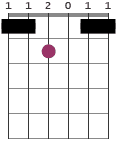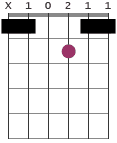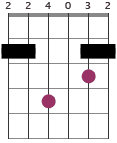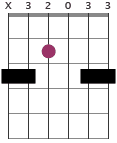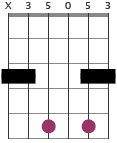Partial capo tunings and chords
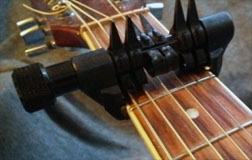 The spider capo is a special designed capo that can create lots of artificial tunings (i.e. including tunings that would be impossible on a guitar without breaking strings etc.). This is an overview of tunings and chords to play with a spider capo.
The spider capo is a special designed capo that can create lots of artificial tunings (i.e. including tunings that would be impossible on a guitar without breaking strings etc.). This is an overview of tunings and chords to play with a spider capo.
If you are reading this, you probably already own a spider capo and understand how it works. Otherwise, you could visit SpiderCapo.com for more information.
Tunings
List of tunings and chords with shortcuts:
If nothing else mentioned, the guitar is always in standard tuning without the capo.
The difference between spider capo and a normal capo
The difference between a spider capo and a normal capo is that a spider capo can fret everything from one to all six strings (although it would be unnecceary to use a spider capo if you like to press down all six strings) and in all possibly configuration.
The difference between spider capo tuning and an alternate tuning without capo
Although, the artificial (or emulated) tunings with a spider capo will have downsides compared to alternate tunings. Since the capo will press down some strings but leave some open “behind” the chords will be affected in some special ways. To summarize, an artificial tuning created by a spider capo (or partial capo) and an alternate tuning will not be exactly the same when you start playing.
One more important thing. In contrast with playing with a normal capo, with a partial capo it is also possible to play behind the capo (which is one of the reasons it’s quite tricky to make chord charts for spider capo).
F Bb DGCF tuning (Gm11 tuning)
Where to place the spider capo: the capo is placed on the 1st fret and pressing down the 1st, 2nd, 5th, 6th strings = 110011.
Explanation: this tuning is named Gm11 tuning, but to be exact, it is an open Gm11 with F in the bass tuning. It can also be considered as a tuning in F major key.
Examples of chords:
Fmaj9sus4: 112011
Bbmaj9: X10211
Bbmaj7: X10231
Fadd4: 113211
F: 133211
F6: 130211
Fsus4: 113311
Gm11: 310011
F6add4: 117711
F6sus4: 118711
Fmaj7sus4: 118911
Suggestion of chord progression: F - Fadd4 - Fmaj9sus4 - Bbmaj9 - F6
One thing to notice, is the full and rich sound in the F - Fsus sequence, compared to the 4-string shapes in standard tuning for the same chords. Besides the 113311 fingerings, Fsus can also be played as 133311 (in other words, the same shapes as for E and Esus otherwise).
Below, one-finger chord voicings:
Fmaj9sus4
Bbmaj9
F# BDG C# F# tuning (Phrygian Mode tuning)
Where to place the spider capo: the capo is placed on the 2nd fret and pressing down the 1st, 2nd, 5th, 6th strings = 220022.
Explanation: On the SpiderCapo website, this tuning is named “Phrygian Mode or Spanish” tuning and it can give a flamenco wibe. The F#BDGC#F# tuning include notes which all belongs to the F# Phrygian mode, see Phrygian mode chord chart for reference. If all strings are played open, they produce a Gmaj13/F# chord.
Examples of chords:
Bm/F#: 224432
F#: 244322
Gmaj13/F#: 255422 / 224032
F#5addG: 244022
Bm9/F#: 227722
F#7sus4: 229922
Notice, that the B minor and F# major chords is the same as with barre shapes in standard tuning.
Gmaj13
GCDGDG tuning (Gsus4 or Csus2 tuning)
Where to place the spider capo: the capo is placed on the 3rd fret and pressing down the 1st, 2nd, 5th, 6th strings = 330033.
Explanation: On the SpiderCapo brochure attached to their product, this tuning is named “G or C Major”. This can be referred to the key, but chords considered, it is either an open Gsus4 or Csus2 with G in the bass tuning.
Chords can be played both behind and in front of the capo, but the behind possibilities are few. Some examples:
G6sus4: 332033
C6sus2: X30233
G/C: X35433
C: X35053
Cmaj7: X35453
Notice, for example, the unique sound of the C chord which include three G notes. Notice also the G6sus chord with fingerings behind the capo:
G6sus
C
See also Capo with open low E-string and Capo with open high E-string.
